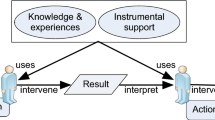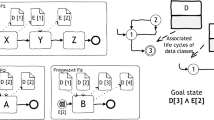Abstract
The information systems development literature indicates that there is no conclusive, empirical evidence that CASE improves the quality of system specifications or the resulting information systems. One role of a CASE tool is to serve as a methodology companion—to assist an analyst in the creation of documentation passed to succeeding phases of the life cycle, and to guide the analyst through a particular systems development methodology. A framework for comparing the level of methodology support provided by a CASE tool is proposed and applied to 27 structured analysis methodology rules. The framework contains seven levels of rule enforcement, ranging from real-time enforcement of a rule to the absence of enforcement for a rule. The methodology enforcement framework is then applied to two popular, commercial CASE tools. Each CASE tool was used by eight project teams over a two month period to construct a functional specification for a hotel information system. The goal of the study was to examine the influence on the functional specification of the level of methodology support provided by the CASE tool for each structured analysis methodology rule. Methodology errors in the system specification were noted for each structured analysis methodology rule. An analysis of the frequency of errors indicates that internal consistency rules are easily adhered to regardless of the level of methodology support provided by the CASE tool, while hierarchical consistency rules are adhered to more frequently in the presence of rigorous methodology support.
Similar content being viewed by others
References
Adelson, B., and Soloway, E. 1985. The role of domain experience in software design. IEEE Transactions on Software Engineering SE-11: 1351–1360.
Alavi, M. 1993. Making CASE an organizational reality. Strategies and new capabilities needed. Information Systems Management 10(2): 15–20.
Baram, G., and Steinberg, G. 1989. Selection criteria for analysis and design CASE tools. Software Engineering Notes 14(6): 73–80.
Baram, G., Steinberg, G., and Nosek, J. 1990. Evaluation of ease of use of CASE tool by first time users. Proceedings of the Annual Meeting of the American Institute for Decision Sciences (Whitten, B. and Gilbert, J., eds.), Cincinnati, OH: American Institute for Decision Sciences, 934–936.
Basili, V. R., Selby, R. W., and Hutchens, D. H. 1986. Experimentation in software engineering. IEEE Transactions on Software Engineering SE-12: 733–743.
Batra, D., Hoffer, J. A., and Bostrom, R. P. 1990. Comparing representations with relational and EER models. Communications of the ACM 33: 126–139.
Boehm, B. W. 1981. Software Engineering Economics. Englewood Cliffs, NJ: Prentice Hall.
Boehm, B. W., McClearn, R., and Unfrig, D. 1975. Some experiences with automated aids to the design of large-scale reliable software. IEEE Transactions on Software Engineering 1: 125–133.
Brooks, F. P. 1987. No silver bullet: Essence and accidents of software engineering. Computer 20(4): 10–19.
Burkhard, D. L. 1989. Implementing CASE tools. Journal of Systems Management 405: 20–25.
Cadre Technologies. 1988. Teamwork/PCSA User's Guide. Providence, RI: Author.
Crosslin, R. L., Bergin, T. J., and Stott, J. W. 1993. Critical factors influencing the future of computer-aided software engineering. Computer-Aided Software Engineering: Issues and Trends for the 1990s and Beyond (Bergin, T. J., Ed.), Harrisburg, PA: Idea Group, 616–637.
Crow, G. B. 1990. BriefCASE—The Collegiate Systems Development Tool. Cincinnati, OH: South-Western.
Davis, G. B. 1982. Strategies for information requirements determination. IBM Systems Journal 211: 4–30.
Day, D. 1995. User responses to constraints in computerized design tools. Unpublished doctoral dissertation, Syracuse University, Syracuse, NY.
DBMS. July 1991. CASE tool roundup. DBMS: 62–69.
Dennis, A. R., George, J. F., Jessup, L. M., Nunamaker, J. F., Jr., and Vogel, D. R. 1988. Information technology to support electronic meetings. MIS Quarterly 12: 591–624.
Everest, G. C., and Alanis, M. 1992. Assessing user experience with CASE tools: An exploratory analysis. Proceedings of the 25th Hawaii International Conference on System Sciences (Nunamaker, J. F. Jr., Ed.), Los Alamitos, CA: IEEE Computer Society Press, 343–352.
Frolick, M. N., Wilkes, R. B., and Rainer, R. K. 1993. Is CASE living up to its promises? Laboratory experiments comparing manual and automated design approaches. Journal of Computer Information Systems 334: 72–76.
Golden, J. R., Mueller, J. R., and Anselm, B. 1981. Software cost estimating: Craft or witchcraft. Data Base 123: 12–14.
Haase, V., and Koch, G. 1982. Developing the connection between user and code. Computer 155: 10–11.
Hannafin, M. J. 1984. Guidelines for using locus of instructional control in the design of computer-assisted instruction. Journal of Instructional Development 73: 6–10.
Heiat, A., and Heiat, N. 1992. The effect on student learning of integrating CASE tools in MIS curricula. Interface: The Computer Education Quarterly 141: 43–45.
Henderson, J. C., and Cooprider, J. G. 1990. Dimensions of I/S planning and design aids: A functional model of CASE technology. Information Systems Research 1: 227–254.
Hutchins, E. L., Hollan, J. D., and Norman, D. A. 1986. Direct manipulation interfaces. User Centered System Design: New Perspectives on Human-Computer Interaction (Norman, D. A., and Draper, S. W., Eds.), Hillsdale, NJ: Lawrence Erlbaum Associates.
Intersolv. 1989. Excelerator Version 1.9 Application Guide. Rockville, MD: Author.
Jankowski, D. J. 1994a. Computer-aided systems engineering methodology support and its effect on the output of structured analysis. Unpublished doctoral dissertation, University of Arizona, Tucson.
Jankowski, D. J. 1994b. The feasibility of CASE structured analysis methodology support. Software Engineering Notes 192: 72–82.
Jankowski, D. J., and Norman, R. J. 1992. Computer-aided software engineering CASE technology in the information systems curriculum: Current practice. The Journal of Computer Information Systems 323: 6–14.
Jones, C. 1986. Programming Productivity. New York: McGraw-Hill.
Kapur, G. 1986, December 1. Productivity tools betray promises of MIS nirvana. Computerworld 20: 61–78.
Kemerer, C. F. 1989. An agenda for research in the managerial evaluation of computer-aided software engineering CASE tool impacts. Proceedings of the 22nd Hawaii International Conference on System Sciences (Shriver, B., Ed.), Los Alamitos, CA: IEEE Computer Society Press, 219–228.
Kemerer, C. F. 1992. How the learning curve affects CASE tool adoption. IEEE Software 93: 23–28.
Khailany, A., Sanchez, P., and Lee, L. 1985. On software maintenance costs. Proceedings of the Annual Meeting of the American Institute for Decision Sciences (Hartman, B. and Ringuest, J., Eds.), Cincinnati, OH: American Institute for Decision Sciences, 321–324.
Loy. P. 1993. The method won't save you but it can help. Software Engineering Notes 181: 30–34.
Martin, M. 1995. The case against CASE. Journal of Systems Management 461: 54–57.
McClure, C. 1989. CASE is Software Automation. Englewood Cliffs, NJ: Prentice Hall.
McDermid, D. C. 1990. Software Engineering for Information Systems. Oxford, UK: Blankwell Scientific Publishing.
McKeen, J. D. 1983. Successful development strategies for business information systems. MIS Quarterly 73: 47–65.
Miller, L. 1974. Programming by non-programmers. International Journal of Man-Machine Studies 6: 237–260.
Moher, T., and Schneider, G. M. 1982. Methodology and experimental research in software engineering. International Journal of Man-Machine Studies 16: 65–87.
Nunamaker, J. F., Jr., Dennis, A. R., Valacich, J. S., Vogel, D. R., and George, J. F. 1993. Group support systems research: Experience from the lab and field. Group Support Systems (Jessup, L. M., and Valacich, J. S., Eds.), New York, MacMillan, 125–145.
Page-Jones, M. 1992. The CASE manifesto. CASE Outlook 61: 33–42.
Purvis, R. L., and Sambamurthy, V. 1992. A comparative investigation of system design methodologies [Summary]. Proceedings of the Annual Meeting of the American Institute for Decision Sciences (Sumichrast, R. T., Ed.), Cincinnati, OH, American Institute for Decision Sciences, 864.
Putnam, L. H. 1978. A general empirical solution to the macro software sizing and estimating problem. IEEE Transactions on Software Engineering SE-4: 345–361.
Roberts, T. L. 1980. Evaluation of Computer Text Editors Doctoral Dissertation, Stanford University. Dissertation Abstracts International 40: 5338B.
Robillard, P. 1989. A project-based software course: The myth of the “real world”. Proceedings of the 1989 SEI Conference on Software Engineering Education (Gibbs, N. E., Ed.), New York, Springer-Verlag, 297–308.
Rozman, I., Györkös, J., and Rizman, K. 1992. Understandability of the software engineering method as an important factor for selecting a CASE tool. Software Engineering Notes 173: 43–46.
Rubin, H. A. 1983. Macro-estimation of software development parameters: The ESTIMACS system. SOFTFAIR—Software Development: Tools, Techniques, and Alternatives. Los Alamitos, CA: IEEE Computer Society Press, 109–118.
Shafer, L. I., and Shafer, D. F. 1993 Establishing a CASE toolbox. 15 steps to selecting CASE tools. Information Systems Management 101: 15–23.
Shultz, S. 1989. Du Pont's I/S team builds a good case for CASE tools. Chief Information Officer Journal 14: 26–28.
Silver, M. S. 1990. Decision support systems: directed and nondirected change. Information Systems Research 1: 47–70.
Sime, M. E., Green, T. R. G., and Guest, D. J. 1977. Scope making in computer conditionals—A psychological evaluation. International Journal of Man-Machine Studies 9: 107–118.
Subramanian, G. H., and Gershon, M. 1991. The selection of computer-aided software engineering tools: A multi-criteria decision making approach. Decision Sciences 22: 1109–1123.
Troy, D. A., and Zweben, S. H. 1981. Measuring the quality of structured designs. The Journal of Systems and Software 2: 113–120.
Vessey, I., Jarvenpaa, S. L., and Tractinsky, N. 1992. Evaluation of vendor products: CASE tools as methodology companions. Communications of the ACM 354: 90–105.
Visible Systems. 1989. The CASE Primer. Waltham, MA: Author.
Walston, C. E., and Felix, C. P. 1977. A method of programming measurement and estimation. IBM Systems Journal 161: 54–73.
Wrigley, C. D., and Dexter, A. S. 1987. Software development estimation models: A review and critique. Proceedings of the Administrative Sciences Association of Canada: MIS Division (Barki, H., Ed.), Toronto, Ontario, Administrative Sciences Association of Canada, 125–138.
Wrigley, C. D., and Dexter, A. S. 1988. A model for estimating information system requirements size: Preliminary findings. Proceedings of the 9th International Conference on Information Systems (DeGross, J. and Olson, M., Eds.), Baltimore, MD, Association for Computing Machinery, 245–255.
Wynekoop, J. L., and Conger, S. A. 1991. A review of computer aided software engineering research methods. Information Systems Research: Contemporary Approaches & Emergent Traditions (Nissen, H., Klein, H., and Hirscheim, R., Eds.), Amsterdam, North-Holland, 301–325.
Yellen, R. E. 1990. Systems analysts performance using CASE versus manual methods. In (J. F. Nunamaker, Jr. Ed.), Proceedings of the 23rd Hawaii International Conference on System Sciences, Los Alamitos, CA: IEEE Computer Society Press, 497–500.
Yourdon, E. 1992. Decline & Full of the American Programmer. Englewood Cliffs, NJ: Yourdon Press.
Yourdon, E., and Constantine, L. L. 1979 Structured Design: Fundamentals of a Discipline of Computer Program and Systems Design. Englewood Cliffs, NJ: Yourdon Press.
Zagorsky, C. 1990. Case study: Managing the change to CASE. Journal of Information Systems Management 7(3): 24–32.
Zucconi, L. 1989. Selecting a CASE tool. Software Engineering Notes 142: 42–44.
Author information
Authors and Affiliations
Rights and permissions
About this article
Cite this article
Jankowski, D. Computer-Aided Systems Engineering Methodology Support and Its Effect on the Output of Structured Analysis. Empirical Software Engineering 2, 11–38 (1997). https://doi.org/10.1023/A:1009790131937
Issue Date:
DOI: https://doi.org/10.1023/A:1009790131937




